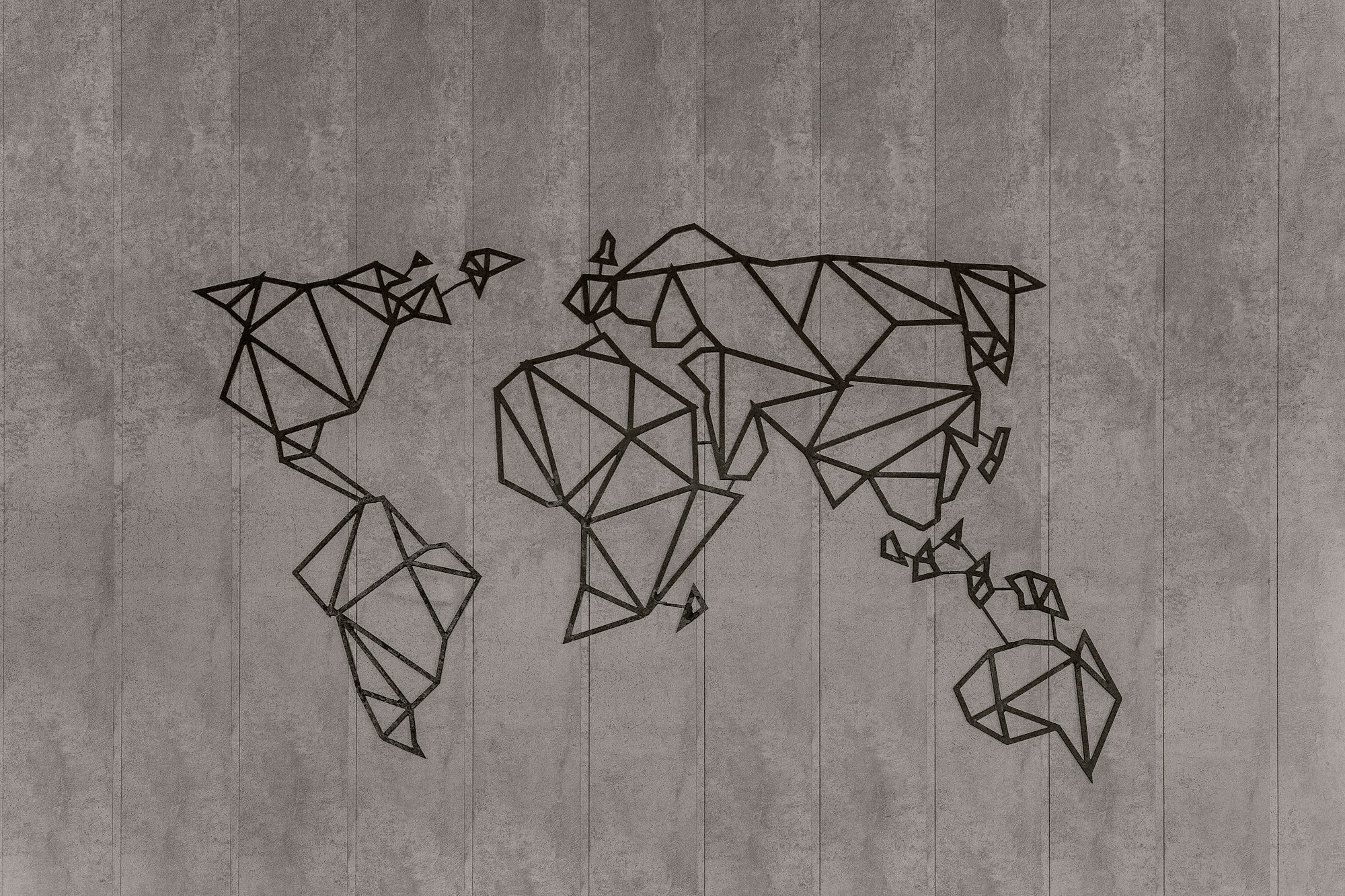The Map Imposes on the Territory
The map is not the territory – Alfred Korzybski, 1931 In the Great Stage Theory Debate, Korzybski's famous quote has been referenced a great deal as a reason (or even the reason) to accept the mismatches between any given theory and the reality of living individuals and cultures.

Point of view: uneasy co-existence
The map is not the territory
– Alfred Korzybski, 1931
In the Great Stage Theory Debate, Korzybski's famous quote has been referenced a great deal as a reason (or even the reason) to accept the mismatches between any given theory and the reality of living individuals and cultures. The opposing view is that labeling anyone based on a stage theory is violence, regardless of the intent or level of understanding that such a label never tells the whole story.
The problem with applying Korzybski's quote in the context of stage theories is that it positions the map as a neutral approximation. It is not the territory, but that is expected. The quote is a reminder to check back in with reality, not to throw away the map. Which is why I changed the quote:
The map imposes on the territory
– Henry Andrews, 2021
Applying a map to living systems is not a neutral operation. The observer affects the observed. No matter how detailed and thorough the map, it constrains the possibilities: this is the fundamental truth of Korzybski's original quote. And when a person knows they are being fitted to a map, that knowledge of their position on the map feeds back and informs their self-image. The act of mapping has changed the territory, brining it closer to, or possibly entirely within, the constraints set by the map.
This is further reflected in the minds of everyone who now knows how the map was applied to the mapped person. Their impressions of the mapped person are now at least somewhat constrained by their knowledge of the mapping. Even with a conscious effort to avoid judgements and assumptions, the map is still having an impact subconsciously.
It does not matter how well the person who applied the map understands that it is an approximation. In fact, the more skill required to work with the map, the more likely the mapped person, and the people who interact with them, will mis-apply the map, resulting in an even more drastic constraining of possibilities. This is where E-C theory and particularly Spiral Dynamics (due to its easy-to-remember-and-toss-around color scheme) as an applied form cannot escape a certain amount of difficulty. SD is a complex, nuanced system with (at least) two levels of training and certification.[1] It is very easy to think you know it by learning the colors, but many people end up with a simplistic type system and never learn any further details.
"You're doing it wrong!"

Of all the arguments defending stage theories in general and Spiral Dynamics (SD) in particular, I find the "those people are just using it wrong" to be the least convincing.[2] I've used the argument myself, and it rarely if ever solves whatever misunderstanding caused me to bring it up. For one thing, to really follow through you have to explain the "real" way to apply the theory, and that is difficult for exactly the same reason that becoming truly proficient with the theory is difficult.
In order to really apply SD safely, not only does the practitioner need to have a very deep (Level 2 certified?) understanding of the theory, but the people to whom it is applied, and the people around them who will know about the application, need to be equally proficient. And even then, there will still be a constraining impact.
I think I can fairly claim a pretty deep understanding of E-C theory and the core aspects of SD that come directly from it. I do not deeply understand the change management aspects that were further developed in SD. But I understand congruence of systems and life conditions. I understand "systems in people, not types of people" and "chords not notes." And I yet still feel the constraints even when applying the theory to myself. It shapes my thinking, because that is what it is supposed to do. Provide a way to think about people and their interactions that is easier to work with than the "territory" itself.
Even with the best of intentions, to facilitate rather than control, to support rather than deny, with full awareness of the nuances and also the limitations involved, the map still imposes on the territory.
An algorithm for generating maps?

In a comment on one of the many social media posts relating to the stage theory debate, Jon Freeman quotes Dr. Michael Niblack as having "described SDi not as a map, but as a map-making algorithm." This is a mental shift worth contemplating. A map that is custom-built for a specific time, person/group, and situation will be more accurate (and therefore less impactful in a damaging sense) than a generic one. Jon notes:
...the inherent out-of-dateness of any map is only effectively dealt with when we can continually redraw it in response to the living nature of the territory. When treated in this way, the model enables us to respond more intelligently in real time.
For me, this really gets deep into both the power and difficult of applying SD/SDi. Not only do all involved have to have fairly deep understanding as I have outlined above, but also there must be ongoing re-evaluation and re-application. Again, I am not denying the flexibility and nuance present in SD and the benefits of its proper use. But I am leaning into the criticism around labeling, and the core problem remains: eventually, the practitioner leaves, people with less understanding remember a few things such as what colors got attached to them and/or their group, and the more reductionist interpretation takes hold.
It's a deep problem that is not at all specific to Spiral Dynamics, but it is substantially present with that system. We cannot ignore that someone with a substantially larger audience (Ken Wilber) has extracted a reductive parallel (the AQAL "altitudes" with its own not-entirely-different color scheme) that a great many people now throw around without anything resembling deep understanding of Gravesian theory. Yet many often call it Spiral Dynamics even though it really is not, probably because Wilber often refers to it as "fixing" the SD color scheme rather than being consistently clear that the "altitudes" have a different purpose. And we cannot ignore that an entire system/stage (Green) has been demonized in part due to its improper reduction to American "progressive" (leftist) political and cultural views, while another (Turqouise) has been exalted.
We don't throw away critically important tools simply because they are misused. But we do try to find the most usable / least abusable form. Most of us do not start fires for our heating needs by striking a match. We have automatic furnaces, and stovetop burners with automatic starters (and gas with a smell added to avoid leaving the gas leaking) or electric coils. Here in California, we are very conscious of the danger of fire while camping, and (for the most part) accept limits on such activities. As a society, we have invested a great deal of resources and innovation in managing fire safely.
How can we invest in Gravesian theory to benefit from its insights while minimizing the chance of burning everything down?
Not a map, but navigation tools

We're not going to get away from this problem by making a better map that's easier to explain, or even by conceptualizing SD as a map-making algorithm. We might reduce the problems, but they will always be there. And the impact of applying such maps can simultaneously be too subtle to notice at the time and yet also have profound long-term effects. Sometimes (hopefully very often!) in a positive way, which is why the system has remained in use for decades. But sometimes the outcome is negative.
There is a fundamental aspect of life where we all need help, and that is understanding ourselves and each other well enough to truly effectively communicate, collaborate, and navigate conflicts. The point of something like E-C theory is to help us understand and mitigate things like mismatched values that can cause us to talk past each other. The underlying patterns that Gravesian theory highlights provide a way to see and understand those sorts of problems.
How do we benefit from those patterns without imposing a map? The answer, I think, is to have the theory do less. When applying the theory, rather than testing for acceptance or rejection of a rather complex set of views that have been associated with each level, find the simplest way to prompt people to reflect on how the fundamental underlying patterns appear for them in a given moment. This should have the effect of helping people understand where they are, for themselves and in relation to others, without constraining how they use that information. Exactly how that should work will be the focus of another article to be published within the next week or so.
Jon Freeman closes the comment I referenced above with the following:
This is also where we might find the simplicity the other side of complexity and increase our willingness to trust in the inherent intelligence of the human ecosystem, allowing it to heal itself from its ground-level of awareness so that our interventions are less about poking about and changing things top-down based on what we think, and more about pulling out of the system the elements that prevent it from seeing itself and thinking for itself. Nature is more intelligent than we are and most of our challenges right now derive from our attempts to control and manage it. And no map tells us what to do mid-journey when we find that the river is in flood.
He was talking about the idea of continually generating maps in a dynamic situation, but I think it's an excellent general summary of our shared goals even if our proposed paths are different.
I think we find the simplicity by figuring out the minimal prompts that the theory can offer to help people understand how they and others are engaging with whatever is going on that they're using Gravesian theory to help with. This should produce and opening-up of possibilities rather than a constriction, however well-intentioned. It should make it easier to deal with the unexpected flood because it avoids setting the expectation that there is no flood.
This approach should facilitate that need to "continually redraw" by not drawing maps in the first place. Instead, the goal is to orient yourself explore the immediate environment and circumstances, which naturally lends itself to iteration. And when people come up with their own answers to prompts, instead of being told "your answers match X, Y, and Z", then they can weave their own answers into their situation as they see fit. Since the answers will always be specific to the people, time, and place, they will not easily be misused to classify and pigeonhole.
I think this is how we unlock that "inherent intelligence" of natural ecosystems. Use the lightest touch, the least nudge, and then stand back and see where the living system goes.
- 1 This should not be taken as a criticism of Spiral Dynamics / SDi certification. When hiring a practitioner of any skill, it is important to be able to rely on them having an appropriate understanding of that skill, and certification is how this is accomplished. My critique is about what happens given that many who talk about SD/SDi are not trained in any way.
- 2 This is not about whether anything is the theory's "fault" in the sense of "if we just prove the theory innocent than we can move on." It's about what has actually happened over the last several decades regardless of anyone's intent, and what we can and should do about that.

